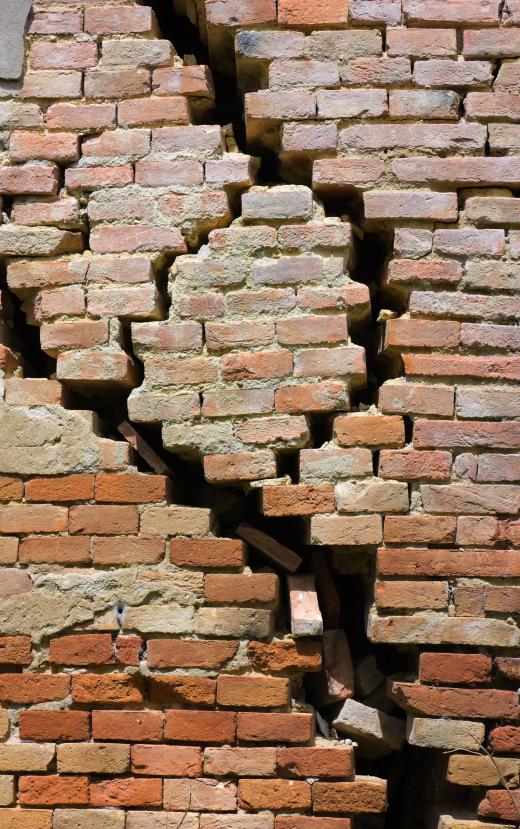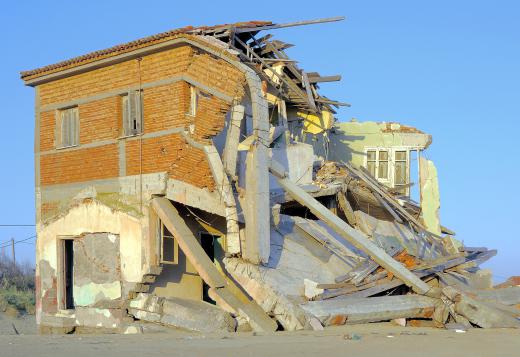What are Aftershocks?
 Mary McMahon
Mary McMahon
Aftershocks are lesser earthquakes that occur after a major one, along the same fault. They can be unsettling for people who experienced the initial earthquake because they do not always fall into a recognizable pattern or system, jolting people and houses without warning. Because, like all earthquakes, they cannot be predicted, people who experience an earthquake should be prepared for smaller ones to follow and take steps to prepare themselves, including getting family members and pets out of unsafe structures.
An earthquake is caused by stress under the Earth's crust. There are a number of different types of earthquakes, and they vary in intensity from very mild quakes that are barely felt to severe ones that cause large amounts of damage and can trigger tsunamis and volcanic eruptions. The actual sensation of moving earth is caused by seismic waves, which are measured on the Richter Scale. The Richter Scale classifies intensity in magnitudes of 10: an earthquake that measures four, for example, is 10 times more intense than a three. Aftershocks follow almost every earthquake, as the ground settles and adjusts itself, and they can sometimes be very severe.

Aftershocks happen along the same fault line that the initial earthquake occurred on, and they can go on for months. The longer the delay, the more difficult it can be to distinguish between an aftershock and an entirely new earthquake. Seismologists look at the epicenter of the quake, the seismic history of the area, and the type of fault to determine whether or not a new earthquake is connected to a past major one. Generally, the longer the time period after a major quake, the less likely these smaller quakes are, although a major seismic event in a normally calm area can stimulate large aftershocks for months.

Generally, aftershocks are less strong than the initial quake, but they can still do a lot of damage, especially to structures. Structures weakened by the original quake may collapse, which put immense amounts of stress on compromised support beams. For this reason, people are encouraged to evacuate buildings after an earthquake, in case later quakes cause the building to fall. After a major earthquake, buildings, elevated roadways, and bridges should be inspected to determine whether or not they are safe, and people should be wary of falling trees and power lines.
AS FEATURED ON:
AS FEATURED ON:














Discussion Comments
@fify - It would be great if they could predict earthquakes, although to some extent I wonder what good it would do. I mean, they already know that places like Haiti for example are prone to earthquakes, but people are too poor to do anything about it. Just like places like San Francisco know they are prone to earthquakes and presumably have building codes in place to deal with it.
I suppose at least you'd be able to evacuate people and warn about tsunamis and things like that. Although since aftershocks can go on for long periods of time, I wonder how much hassle it would be to evacuate people for that amount of time.
@turkay1 - The scary thing is that aftershocks can sometimes do even more damage than the original quake. There was a big earthquake in Christchurch, New Zealand in late 2010 that seemed pretty bad and did a lot of damage, but no one died from it and the aftershocks just seemed annoying.
Then there was an aftershock in 2011 that was so close to the surface it actually did much more damage than the original quake and basically flattened half the city, killing almost 200 people.
The aftershocks went on for months and months afterwards and there were people even a year on who still couldn't move back into their houses. It's really the worst part of an earthquake, in my opinion, that it doesn't just stop with the original quake but keeps going for so long after.
I read a paper on this for class. Aftershocks cannot be predicted but they are known to follow something called "Omori's Law."
From what I understood, aftershocks occur with a reduced rate. So when the first aftershock takes place after an earthquake, it's possible for scientists to figure out when and where the next one might take place. Omori's law is an equation which helps them figure out the pattern of aftershocks after an earthquake.
I think some scientists are also trying to figure out if this law can be applied to earthquakes also. Wouldn't it be fantastic if we could use what we know of seismic waves and patterns to start predicting earthquakes?
Every time I watch earthquake victims on TV, I see them living in make up shelters or tents outside, regardless of whether their houses were damaged or not. I think even people who were not hurt during the actual quake are too afraid of aftershocks and prefer to be outside even if it is in the middle of winter. They remain outside for months until the government takes action to get them situated somewhere.
I feel so helpless when I see them in that situation but I realize that they are much safer outside than their houses. Especially if we don't know whether aftershocks will happen or not. I think it's way too traumatic for them to think about going into buildings anyway, in fear that it might collapse.
Post your comments